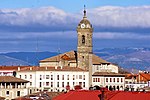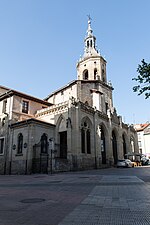Church of San Miguel, Vitoria-Gasteiz
14th-century Roman Catholic church buildings in SpainBien de Interés Cultural landmarks in ÁlavaChurches in Vitoria-GasteizGothic architecture in the Basque Country (autonomous community)Spanish church stubs

The Church of San Miguel (Spanish: Iglesia de San Miguel Arcángel, Basque: San Migel Goiaingeruaren eliza) is a church located in Vitoria-Gasteiz, Basque Country, Spain. It was declared Bien de Interés Cultural in 1995.The retable of the church is a baroque altarpiece, it is one of the finest works by Gregorio Fernández and his workshop.
Excerpt from the Wikipedia article Church of San Miguel, Vitoria-Gasteiz (License: CC BY-SA 3.0, Authors, Images).Church of San Miguel, Vitoria-Gasteiz
Aihotz plaza/Plaza del Machete, Vitoria-Gasteiz Alde Zaharra/Casco Viejo
Geographical coordinates (GPS) Address External links Nearby Places Show on map
Geographical coordinates (GPS)
| Latitude | Longitude |
|---|---|
| N 42.84737 ° | E -2.67285 ° |
Address
San Migel eliza/Iglesia de San Miguel
Aihotz plaza/Plaza del Machete
01001 Vitoria-Gasteiz, Alde Zaharra/Casco Viejo
Autonomous Community of the Basque Country, Spain
Open on Google Maps











